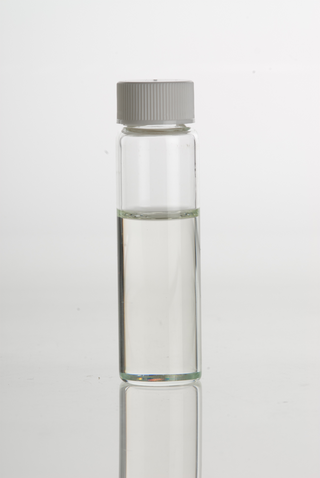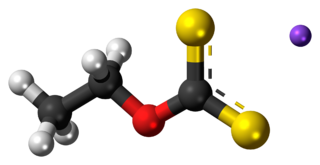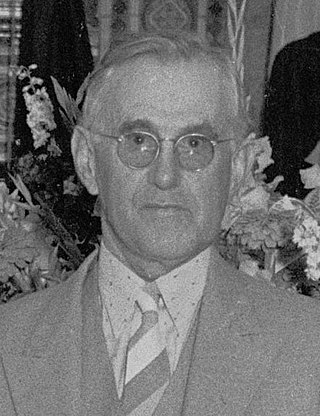Related Research Articles

The mineral bastnäsite (or bastnaesite) is one of a family of three carbonate-fluoride minerals, which includes bastnäsite-(Ce) with a formula of (Ce, La)CO3F, bastnäsite-(La) with a formula of (La, Ce)CO3F, and bastnäsite-(Y) with a formula of (Y, Ce)CO3F. Some of the bastnäsites contain OH− instead of F− and receive the name of hydroxylbastnasite. Most bastnäsite is bastnäsite-(Ce), and cerium is by far the most common of the rare earths in this class of minerals. Bastnäsite and the phosphate mineral monazite are the two largest sources of cerium and other rare-earth elements.

Copper extraction refers to the methods used to obtain copper from its ores. The conversion of copper ores consists of a series of physical, chemical and electrochemical processes. Methods have evolved and vary with country depending on the ore source, local environmental regulations, and other factors.

In mining, gangue is the commercially worthless material that surrounds, or is closely mixed with, a wanted mineral in an ore deposit. It is thus distinct from overburden, which is the waste rock or materials overlying an ore or mineral body that are displaced during mining without being processed, and from tailings, which is rock already stripped of valuable minerals.

Froth flotation is a process for selectively separating hydrophobic materials from hydrophilic. This is used in mineral processing, paper recycling and waste-water treatment industries. Historically this was first used in the mining industry, where it was one of the great enabling technologies of the 20th century. It has been described as "the single most important operation used for the recovery and upgrading of sulfide ores". The development of froth flotation has improved the recovery of valuable minerals, such as copper- and lead-bearing minerals. Along with mechanized mining, it has allowed the economic recovery of valuable metals from much lower-grade ore than previously.

Mineral processing is the process of separating commercially valuable minerals from their ores in the field of extractive metallurgy. Depending on the processes used in each instance, it is often referred to as ore dressing or ore milling.

Pine oil is an essential oil obtained from a variety of species of pine, particularly Pinus sylvestris. Typically, parts of the trees that are not used for lumber — stumps, etc. — are ground and subjected to steam distillation. As of 1995, synthetic pine oil was the "biggest single turpentine derivative." Synthetic pine oils accounted for 90% of sales as of 2000.
Foam fractionation is a chemical process in which hydrophobic molecules are preferentially separated from a liquid solution using rising columns of foam. It is commonly used, albeit on a small scale, for the removal of organic waste from aquariums; these units are known as "protein skimmers". However it has much broader application in the chemical process industry and can be used for the removal of surface active contaminants from waste water streams in addition to the enrichment of bio-products.
Induced gas flotation (IGF) is a water treatment process that clarifies wastewaters by the removal of suspended matter such as oil or solids. The removal is achieved by injecting gas bubbles into the water or wastewater in a flotation tank or basin. The small bubbles adhere to the suspended matter causing the suspended matter to float to the surface of the water where it may then be removed by a skimming device.

The following outline is provided as an overview of and topical guide to mining:
Minerals Separation v. Hyde, 242 U.S. 261 (1916), is a United States Supreme Court case on the patent protection of froth flotation.

Sodium ethyl xanthate (SEX) is an organosulfur compound with the chemical formula CH3CH2OCS2Na. It is a pale yellow powder, which is usually obtained as the dihydrate. Sodium ethyl xanthate is used in the mining industry as a flotation agent. A closely related potassium ethyl xanthate (KEX) is obtained as the anhydrous salt.

James McDonald Hyde was a metallurgist who designed the first significant froth flotation plant in the United States. He also served as a member of the Los Angeles, California, City Council from 1931 to 1939.
Sepro Mineral Systems Corp. is a Canadian company founded in 1987 and headquartered in British Columbia, Canada. The outcome of the acquisition of Sepro Mineral Processing International by Falcon Concentrators in 2008, the company's key focus is the production of mineral processing equipment for the mining and aggregate industries. Sepro Mineral Systems Corp. also provides engineering and process design services. Products sold by Sepro include grinding mills, ore scrubbers, vibrating screens, centrifugal gravity concentrators, agglomeration drums, and dense media separators. The company is also a supplier of single source modular pre-designed and custom designed plants and circuits.

A buddle pit or buddle pond is an ore processing technique that separates heavier minerals from lighter minerals when the crushed ore is washed in water. This technique was used in the mining industry to extract metals such as tin, lead and zinc. Many buddles seen today date from the Victorian era and are often circularly shaped. There was also a variation called the concave buddle, which had a concave bottom.
Bitumen froth treatment is a process used in the Athabasca oil sands (AOS) bitumen recovery operations to remove fine inorganics—water and mineral particles—from bitumen froth, by diluting the bitumen with a light hydrocarbon solvent—either naphthenic or paraffinic—to reduce the viscosity of the froth and to remove contaminants that were not removed in previous water-based gravity recovery phases. Bitumen with a high viscosity or with too many contaminants, is not suitable for transporting through pipelines or refining. The original and conventional naphthenic froth treatment (NFT) uses a naphtha solvent with the addition of chemicals. Paraffinic Solvent Froth Treatment (PSFT), which was first used commercially in the Albian Sands in the early 2000s, results in a cleaner bitumen with lower levels of contaminates, such as water and mineral solids. Following froth treatments, bitumen can be further upgraded using "heat to produce synthetic crude oil by means of a coker unit."

The Jameson Cell is a high-intensity froth flotation cell that was invented by Laureate Professor Graeme Jameson of the University of Newcastle (Australia) and developed in conjunction with Mount Isa Mines Limited.
An oil water separator (OWS) is a piece of equipment used to separate oil and water mixtures into their separate components. There are many different types of oil-water separator. Each has different oil separation capability and are used in different industries. Oil water separators are designed and selected after consideration of oil separation performance parameters and life cycle cost considerations. "Oil" can be taken to mean mineral, vegetable and animal oils, and the many different hydrocarbons.

Carrie Jane Everson was an American who invented and patented processes for extracting valuable minerals from ore using froth floatation. The Mining Journal noted in 1916 that "as a metallurgist she was a quarter of a century in advance of her profession."

A primary mineral is any mineral formed during the original crystallization of the host igneous primary rock and includes the essential mineral(s) used to classify the rock along with any accessory minerals. In ore deposit geology, hypogene processes occur deep below the Earth's surface, and tend to form deposits of primary minerals, as opposed to supergene processes that occur at or near the surface, and tend to form secondary minerals.

The Foxdale Mines is a collective term for a series of mines and shafts which were situated in a highly mineralised zone on the Isle of Man, running east to west, from Elerslie mine in Crosby to Niarbyl on the coast near Dalby. In the 19th century the mines were widely regarded as amongst the richest ore mines in the British Isles.
References
- ↑ Birrell, Ralph (2000). The Role of Minerals Separation Ltd. in the Development of the Flotation Process. Victoria, Australia: Zlota Press. pp. passim. ISBN 0958587469.
- ↑ Gaudin, A. M. (1932). Flotation. New York, New York: McGraw-Hill. pp. 1–7.
- ↑ Lynch, Martin (2002). Mining in World History. London: Reaktion Books Ltd. p. 208. ISBN 9781861891730.
- ↑ Parsons, A. B. (1933). The Porphyry Coppers. New York, New York: American Institute of Mining and Metallurgical Engineers. p. 453.
- "Historical Note: Minerals Separation Ltd". Australian Science and Technology Heritage Centre. Retrieved 2009-08-21.
- "MINERALS SEPARATION v. HYDE , 242 U.S. 261 (1916)". FindLaw, a Thomson Reuters business. Retrieved 2009-08-21.